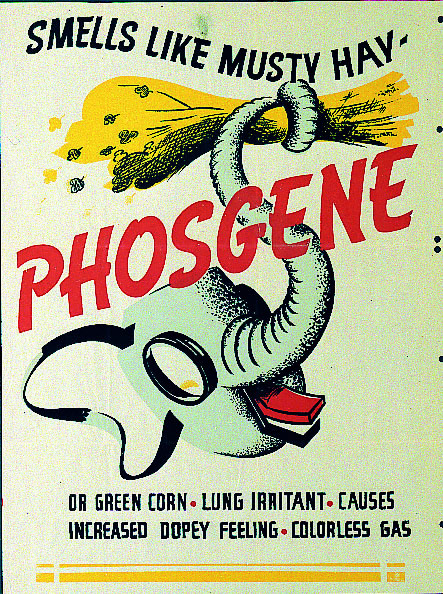Recent research reinforces concerns that new ‘environmentally friendly’ air-conditioning coolant R1234yf (2,3,3,3 tetrafluoropropene) may burn to produce highly poisonous gases hydrogen fluoride and carbonyl difluoride. Carbonyl difluoride – a relative of chemical warfare agent phosphene – may be more stable in air than previously assumed.
You may already be aware of the current debate regarding the replacement of R134A, the traditional coolant gas used in vehicle air-conditioning units, with the flourocarbon gas R1234yf which has been developed as an environmentally more acceptable replacement. Whereas one kilogramme of R134A is equivalent to 1.3 tonnes of CO2 a similar quantity of R1234yf is equivalent to only 4 kilogrammes of CO2. This means that the use of R1234yf would have a considerably reduced negative environmental impact compared with R134A if it is released into the atmosphere, say in a car accident or at the end of a vehicle’s useful life.

EU Legislators already require car manufacturers to use coolants in their new models which meet stricter environmental standards. R134A would not meet these standards but R1234yf meets them and would require minimal changes to the vehicle air-conditioning systems. In the US Chrysler and General Motors have announced they will transition to R1234yf but other manufacturers like Mercedes and Toyota have asked for more time to comply with the new environmental standards for coolants because of concerns about the safety of R1234yf.
In September 2012 Mercedes expressed its concern following flammability tests with R1234yf. Although the coolant was known to produce poisonous hydrogen fluoride when ignited prior researchers had identified that under laboratory conditions this would only occur at temperatures above 900C. Such temperatures were not expected to be generated under normal motoring conditions. Mercedes decided to test this with ‘in-use‘ testing which went beyond the statutory test conditions. They simulated a vehicle which was being run hard to recreate the conditions likely in the exhaust system when travelling at speed along an autobahn or when pulling a trailer up a hill.
Once the temperature of the vehicle’s equipment had been raised under these ‘hard driving’ conditions (to approximately 665C) Mercedes sprayed it with the R1234yf. Their objective was to try and simulate the potential release of air conditioning coolant following an accident. Within seconds the coolant ignited giving off poisonous vapours. Of particular concern during their trial of R1234yf was the production of highly poisonous hydrogen fluoride which produces the corrosive, penetrating hydrofluoric acid when it comes into contact with human tissues. In contact with the eyes it can lead to rapid destruction of the cornea producing blindness. In the testing conditions the windscreen glass of the test vehicle was severely etched by this highly corrosive agent. If the Mercedes scenario is realistic it could potentially lead to horrific injuries to occupants of a crashed vehicle and to emergency response personnel trying to help them.
In the last month further research from the University of Munich has been published which involved a more thorough investigation into the properties of this new coolant (by Michael Feller, Karin Lux, Christian Hohenstein, and Andreas Kornath: “Structure and Properties of 2,3,3,3-Tetrafluoropropene or HFO-1234yf” published in the Zeitschrift für Naturforschung on April 7th 2014.The link is here). In their research the scientists identified that one of the products of HFO 1234yf combustion, Carbonyl Difluoride, made up 20% of the gases produced.
Previously the accepted view of carbonyl difluoride was that it rapidly decomposed on contact with moisture in the air to produce hydrogen fluoride and carbon dioxide. However in the German Press the author of the research was quoted as saying that in his own experience this long held view of the rapid decomposition of carbonyl difluoride needs to be reconsidered. He believed the chemical was more stable than generally accepted and strongly recommended a more thorough evaluation of the risks and dangers associated with release of carbonyl difluoride as part of an in-use study of R1234yf as an air-conditioning coolant.
Carbonyl difluoride is considered to be extremely poisonous having a threshold limit value (TLV) of only 2 ppm (short-term exposure). Animal trials indicate that at similar dosage levels it may be even more acutely toxic than the highly poisonous hydrogen fluoride. Carbonyl Difluoride is also closely related to Phosgene (Carbonyl Dichloride). Phosgene became infamous for its use as a poison gas in the trenches during the first world war. Its use in chemical warfare is now banned.
Based on this latest research and the current level of uncertainty regarding the in-use combustability and resulting gaseous products of air-conditioning coolant R1234yf more research is urgently needed. Already 120,000 vehicles containing the new coolant have been approved for use in Germany. The EU authorities continue to permit its use, quoting crash-tests carried out in 2013 by the German Transport Ministry in which no fire hazard could be identified under conditions that are common or predictable in accordance with the current product safety legislation.

Car manufacturers like Mercedes, BMW and VW are not convinced about the suitability of R1234yf for their next generation of vehicles. They are all working on new higher pressure refrigeration technology which will use Carbon Dioxide as a coolant. Although the equipment will be more expensive the gas is much cheaper and even more environmentally acceptable than R1234yf.
Chris Duggleby
If you are interested in reading my other health focused articles try the following
Torture In The Shower – Face and Body Soap Allergies – Main Suspect: Pears Transparent Soap
Toxic Chemicals in Sex Toys – 18 Vibrators, Cock Rings, Love Balls Tested – Only 3 Get All Clear
My T-shirt Made Me Sick – Textile Allergies – Sinusitis From Your Underwear
